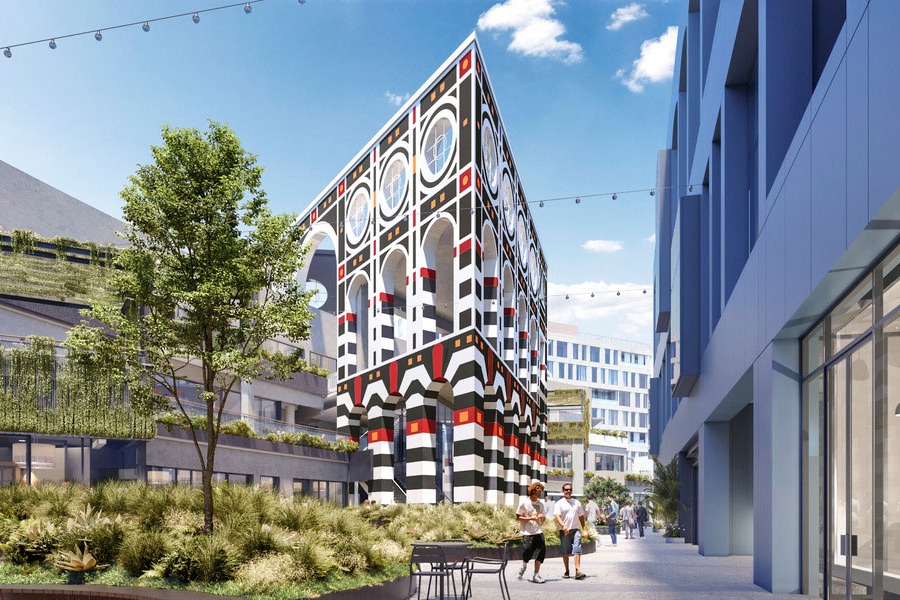Story at a glance:
- Sara Hickman is the sustainability director at Retail Design Collaborative and Studio One Eleven, where she drives sustainable design practices.
- Horton Plaza in downtown San Diego is being reinvented as a tech hub with retail, dining, and more.
- The upgraded plaza is targeting LEED and WELL Platinum and includes a number of sustainability features, including an impressive solar array and San Diego’s first onsite blackwater system.
Growing up on a three-acre plot of land in Massachusetts, Sara Hickman has always felt connected to nature. But it was her love of math, art, LEGOs, and Lincoln Logs that really brought out the builder in her. Over time architecture became something Hickman and her family bonded over, particularly with her dad.
“My father was very much a Renaissance man,” she says. “Both of the houses I grew up in he built from scratch. He wasn’t an architect; he was in insurance and IT. Building was something he just taught himself.” Together Hickman and her father loved to pore over floorplans. On family vacations, they’d all drive around to look at houses and marvel at the architecture.
Hickman studied architecture at the Wentworth Institute of Technology in Boston before heading west to California. Although sustainability had always been an underlying factor in her life—something “built into who she is,” she says—it wasn’t until Hickman was studying for the LEED exam that she felt the pull to make a change in the green movement.

Courtesy of Stockdale Capital Partners
But not long after graduation, whispers of the recession began. “So instead of sending out a bunch of resumes, I got involved,” she says. Hickman started volunteering at USGBC-LA, Sustainable Works, and other local nonprofit sustainability groups, where she worked on a variety of projects, from creating graphics to teaching residents about sustainability. She also started attending trainings and conferences on her own dime to fully immerse herself in the sustainability world. “It was like getting a master’s degree,” she says.
But it paid off. Through her newfound connections, a friend put Hickman in touch with the owner of Leading Edge, where she worked as the sustainability manager, consulting on more than 20 millions square feet of LEED-certified space.

Courtesy of Stockdale Capital Partners
Education in Action
Today Hickman is the sustainability director at Retail Design Collaborative (RDC) and Studio One Eleven, where she has driven the firms’ sustainable design practices, educating staff and clients and advocating for environmentally friendly architecture to the outside world for the past three years. A board member of USGBC-LA, she practices what she preaches, biking or walking to work each day.
One of Hickman’s most recent successes is the Horton Plaza project in downtown San Diego. Built in the 1980s, the plaza was originally a mall—one so well-known people would come from out of state to shop there. A collaboration with design firm RIOS, the 10-block, nearly 1 million-square-foot project will now be reinvented as a tech hub, complete with retail, restaurants, public park space, and theaters.
“Horton is a dream come true,” Hickman says. “This is rare, but it was easy right from the start because ownership started asking very early who our audience is, and they tried to understand their wants and needs. Google, Facebook, Microsoft, Apple—they all have very aggressive carbon emissions reductions toward net zero, so they knew we needed LEED Platinum; health and wellness factors, meaning WELL; and carbon neutrality as much as possible.”

Courtesy of Stockdale Capital Partners
Designing Green
As such the project, slated to be completed in summer 2022, will feature numerous sustainable elements. For one, a 2.5 megawatt solar array will stretch across the campus rooftops to achieve Net Zero Carbon for the new offices, which will be fully electric. The project also needed a new central plant, tied in with San Diego’s first onsite blackwater system, which will reduce potable water demand by 50%.
Hickman in particular is overseeing the LEED, WELL, and WiredScore—another point-based system focused on Internet connectivity and resilience—certifications of the project, which is targeting Platinum across all three certifications. Although there are a lot of components to each of these credentials, including specs for healthy materials, lighting, and acoustics, among the most relevant today is how the project is prioritizing indoor air quality.
“I’ve always wanted my WELL projects to incorporate air quality monitoring, and I’ve myself tested three or four different standalone systems to see how they compare to one another in our office, which is LEED Platinum and WELL Gold,” Hickman says. Her system of choice: Aircuity, an air quality monitor system often used in the medical field that spears out to individual spaces from one main hub, which means flexibility for both tenants and building owners. For the Horton Plaza project, because the team doesn’t know who will be working in the space, that flexibility is key.

Courtesy of Stockdale Capital Partners
“Some of those floor spaces are pretty big, and we don’t know how they are going to be broken out,” Hickman says. “The tenants can choose whether they want to hook into that existing Aircuity system. If they want to have their space measured for air quality, they can; it’s up to the tenant whether they want to install it or not.
“The other piece I love about this project is promoting active circulation,” Hickman says. “Just the nature of the project itself—it has a canyon that runs through the entire project with stairs going up and down, so it really promotes active circulation and wellness.”
And in the end, that kind of wellness, along with the project’s other sustainability initiatives, is exactly what Hickman has built her career around, stemming from those early projects with Lincoln Logs. “Most of us are seeking meaning in our lives, a sense of purpose and value,” Hickman says. “The sustainable design movement opened that door wide open for me.”

